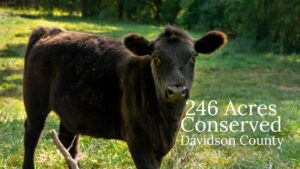
by Greg Cooper, LandTrust intern summer 2015
June 4, 2015

Two long prized pine species have faced a drastic decline as a result past exploitation, a history of fire suppression, and a widespread transition to loblolly pine plantation: the longleaf and shortleaf pine. Currently, the much publicized longleaf pine is on its way to recovery thanks to conservation groups working with private landowners to restore these forests. On the other hand, the shorter needled counterpart of the idyllic longleaf, has not received the attention nor funding it deserves. The shortleaf pine, which was once considered widespread across a wide array of habitats all over the southeast and was highly prized for its form and wood quality, has now been reduced to half of its historical acreage.
This past May, I attended the Shortleaf Pine “101” Workshop in Troy, North Carolina which was sponsored by the Greater Uwharrie Conservation Partnership, US Forest Service and North Carolina Forest Service. This workshop covered everything from the natural history of this species, the methods for its propagation, silvicultural techniques for optimal growth, and the superior economic potential of the shortleaf pine.

The shortleaf pine can be differentiated from other regional pines because of its shorter needles (3-4 inches in length) that occur in groups of 2-3 per fascicle and smaller pine cones (1 to 2 inches long). This pine has a very interesting adaptation that has allowed it to become fire tolerant—the basal crook, which is just below the stem and above the root where the plant makes a 90 degree turn before growing upward again. This adaptation protects the dormant buds from fire that would damage the above ground component of the plant, allowing the baby pine to resprout.
This pine can grow in a variety of sites and settings from southern New York to Florida and as far west as Oklahoma and Texas. They can occur as a dominant species in mixed oak forests or even as a significant component of the interior longleaf pine woodland setting. Generally, ecosystems that have historically been burned or have dry conditions tended to have large numbers of shortleaf pines. Regionally, shortleaf pine dominant forests can be found on several ridgetops in the Uwharrie Mountains, including Birkhead Mountain in the Birkhead Mountain Wilderness.
Economically, shortleaf pine can be very valuable to the timber industry because it tends to maintain its girth with height resulting in a heavier log per its length in comparison to that of loblolly and longleaf pines with equal diameters. This makes the harvest of this pine better suited for valuable pole timber that is used as pilings for piers and telephone poles.

There are many efforts underway to restore the shortleaf pine within the landscape. According to the 2012 Uwharrie National Forest Land and Resource Management Plan, the US Forest Service has set a goal to increase the shortleaf pine component within its forests. In addition, local landowners can utilize several grants offered by the National Resources Conservation Service (NRCS) to restore or manage for shortleaf pine. For further information about shortleaf pines and efforts being undertaken in their restoration, the Shortleaf Pine Initiative has launched a website filled with information from shortleaf pine experts that can be accessed at shortleafpine.net.